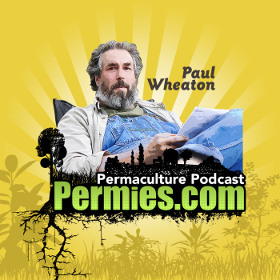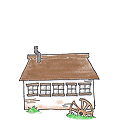 Listen Online
Listen Online  Download
Download  Get all of the podcasts in convenient, giant zip files
Get all of the podcasts in convenient, giant zip files  Subscribe on iTunes
Subscribe on iTunes Summary
Credit:
Summary
Credit: Summary prepared by Julia Winter
In this podcast, Paul discusses the Geoff Lawton DVD "Introduction to
Permaculture Design." He starts with the impressions of Bella, an 8 yr old who watched with interest and really liked the demonstration of how water moves through a landscape. Geoff made a model swale and showed what happened when water was added. He also hears from Erica Strauss, who has a blog nwedible.com that is mostly about growing edibles in Seattle but also about other sustainable activities like air drying clothes, cooking and healthy living in general. She offers the perspective of someone who is not highly schooled in permaculture. Paul says this DVD doesn't do much for him, since he's already pretty knowledgeable on the topic of permaculture. Erica thought that the target audience for this DVD must be people who already have some knowledge about permaculture. Geoff was hard to follow when he waxed theoretical/philosophical and some of the terms used (edge, guilds, patterns of design, design theory, stacking functions, ethics, polyculture), were unfamiliar to her. Jocelyn points out that the water demo was the most concrete and thus the most clear part of the video (although there were a lot of great visuals).
Erica notes that the idea of a landscape that doesn't require as much time and effort from the gardener is really appealing--this is a large part of the appeal of permaculture for her. However, the video disappointed in a lack of much concrete detail about how to accomplish this. Paul noted that this is an 80 minute introductory DVD that was originally followed by a 72 hour "stack of DVDs" for a complete at-home permaculture design course. Erica agrees that after watching this, she wants to hear more, but she's not sure if watching this would make her want to "sign up" for another 72 hours.
Jocelyn notes that Geoff defines "sustainable" as "producing more than it consumes" and states that this can only occur at edges. He's trying to get people to think about getting away from lots of inputs to the land. Later, sustainable is defined as a situation where the soil is increasing in fertility over time.
Paul says that some of
Geoff Lawton's videos are "the best I've ever seen," but this one, well, it's not in that category. Paul thinks Geoff's Food Forest DVD is the best one he's seen. Erica points out that beginners are really looking for techniques that will yield some results: "they really want to taste success." They're probably not interested in hearing about how you
should have a hundred hours of observation for every hour of action. You hook the beginner by allowing them to achieve success.
Paul notes that what appeals to masses of people often doesn't appeal to him and references a talk at a permaculture convergence that did nothing for him, but everybody else seemed to love. Thus, other people may very well love this DVD. Paul is nonplussed by all the discussions of "ethics" in permaculture. He says he's never seen anything that he considers to be permaculture that is also unethical. Erica points out that permaculture sometimes comes across as a worldview/life philosophy/cult/religion rather than a way to grow more food. Paul notes that
Sepp Holzer has never taken a PDC, he doesn't discuss ethics and he doesn't talk about zone 1, zone 2, etc. Erica remembers that the zone discussion was her favorite part of the video. Paul noted that the zone discussion seemed pretty "rural" in focus.
Erica could see that Geoff was able to strategize the interactions of plants years in advance and despaired of ever becoming that savvy. Paul pointed out that all you really need to do is get a good seed mix and let nature figure that part out for you. He compares permaculture to cooking and bemoans the lack of "cookbooks" or "recipes" for permaculture. He notes that such a thing would need to be highly localized in order to work well.
Everybody liked the story of amaranth/pigweed: Geoff noticed that pigweed was volunteering in a spot, and subsequently planted a domesticated version (giant, purple) of amaranth and it thrived. Paul heard Sepp say that where ferns grow is a good spot for potatoes and sunchokes.
Paul expressed concern about galvanized metal used for a raised bed, and Jocelyn pointed out that Paul doesn't like multiple things that other permaculture "bigs" use, like cardboard, newspaper and treated lumber. Erica noted that an "organic matter swale" in the video was pretty darn close to a trash heap (mostly palm fronds, but also furniture, carboard boxes and old clothes) and probably more messy than most beginners would be interested in having near their home. This digresses into a discussion of trash management and recycling electronics, and then into a discussion of living with less impact, sharing functions/skills with others, and other topics.
Paul likes
aquaculture, and Geoff talks about how much food aquaculture can produce in this video. Geoff talks about "biogeography" which was new for everybody as a term, and quite interesting to Paul. Paul liked when he called zone 4 "farm forestry."
Resources
Information on how to get the DVD can be found here
Relevant Links
Podcast 234 – Review of Introduction to Permaculture Design DVD
Permaculture Research Institute of Australia Website
Northwest Edible Life
Introduction to Permaculture Design DVD
GeoffLawton.com
Support the Empire
Help support the empire and get all of the podcasts in bundles
here
To support production of these podcasts, make a donation
here at Paul's Patreon page.











 1
1




 Keep up the great work, I really loved your huglkulture video!
Keep up the great work, I really loved your huglkulture video!
 1
1
















































